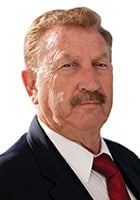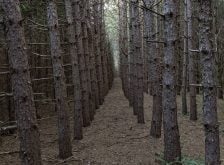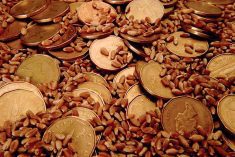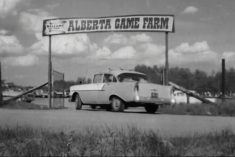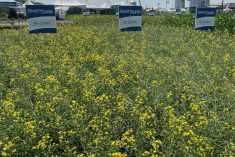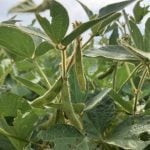What’s in a name? The big imposing animals that roamed the North American prairies and northern woodlands were called buffalo. Strictly speaking, buffalo are African and Asian cattle, distinct species from the North American and European animals. Technically and biologically speaking, our buffalo are not buffalo but bison.
The North American Plains buffalo is classified as Bison bison. The wood bison, is classified as Bison bison athabascae or mountain bison and the European bison as Bison bonasus, also known as wisent.
The world total for the three bison species at present is around 500,000. Of this total, there are as follows:
Read Also

Gentle treatments for pain in the neck
Heading toward year-end, people unknowingly tense up against the cold and busyness, causing neck pain that can often be treated with appropriate support and gentle mobility, athletic therapist Kathlyn Hossack says.
· 185,000 domestic bison in the United States (Bison bison)
· 120,000 domestic bison in Canada (Bison bison)
In Canada’s parks and northern territories there are some 30,000 wild bison of which 10,000 are wood bison. Canadian wood bison have been shipped to Europe and to Alaska, all from Elk Island National Park, Alta., just east of Edmonton. The Yellowhead Highway (Hwy 16) that bisects Elk Island National Park has Plains bison on the north enclosure and wood bison on the south enclosure. All are disease-free-tested livestock.
In the United States, there are free-ranging herds of Plains bison at Yellowstone National Park and a few other locations in both Canada and the United States. In Europe as in North America, the European bison was close to extinction save some 14 animals in Poland. To date, there are now around 7,000 European bison, or wisent, mostly in wild parks in Europe.
The world-famous Alberta Game Farm run by Al Oeming, east of Edmonton on Hwy 14, had a small herd of European wisent. This game farm had the most fantastic collection of wild animals anywhere in the world. The game farm, eons ahead of its competition, opened in 1959 and closed in 2014. A true jewel that closed from a lack of provincial support and animal organizations. The wisent, just like Siberian tigers, alpacas and many rare exotics, were dispersed all over North America.
The real buffalo story
However, let’s continue with the real buffalo story. The animals that are truly called buffalo are Asian buffalo (Bubalus bubalis), which are primarily domesticated animals, mostly in Asia, but there are feral herds in many countries, such as India and Australia. Worldwide, they number around 130 million with some 55 million in India as draft and milk animals — they produce very tough meat.
The African buffalo (Syncerus caffer caffer) or Cape buffalo, with many subgroups, number some 400,000 in that continent. The Asian and African buffaloes are only distantly related to our North American bison.
The North American Plains bison at one time, depending on the source, numbered from 30 million to 60 million and ranged from Northern Canada all the way into Mexico. Incidentally, by the 1870s, the vast herds of Plains bison were almost extinct. Aside from some modest herds of wood bison in the northern territories of Canada, only a small herd of Plains bison existed in Banff National Park.
In the United States, a few enterprising individuals purchased some 13 head of Plains bison in 1884 and turned them loose on the Flathead Reservation in Montana. In 1893, some 30 bison were purchased from a Charles Jones. By 1906, this bison herd, protected by the reservation, numbered around 800 animals. At around this time, the Montana government opened the Flathead bison land to settlers. The Montana bison conservationists knew this major surviving herd would be doomed when the settlers moved in.
The herd was offered to the U.S. government which gave it the thumbs-down. The Canadian government quickly purchased this herd and by 1912 a Michael Pablo delivered more than 700 bison to Canada. Some 600 went to the newly established Buffalo National Park at Wainwright and 85 to Elk Island National Park, Alta. Some 70 buffalo subsequently went to Banff from this Pablo–Allard herd.
This herd of bison assembled at Wainwright was a good mixture of Plains bison from northern and southern areas of the United States. Only a dozen or so bison at this time survived at Yellowstone National Park. Subsequent to 1906, some 300 bison were shipped to Elk Island, Alta., (Edmonton) until fencing could be completed at Wainwright for Buffalo National Park. In 1909, some 300 bison were shipped back to Wainwright and perhaps 50 or more evaded capture at Elk Island National Park and are the ancestors of today’s Plains herd.
Alberta’s Highway 41, nicknamed the Buffalo Trail, follows the bison route from the Flathead Reservation in Montana to Wainwright. Pablo and his U.S. cowboys had a very difficult time driving the world’s last last big bison herd to Wainwright following a litany of gored horses and injured riders up the Canadian prairie but were well paid for the effort.
The bison herd thrived in Buffalo National Park at Wainwright, and in a few decades, it numbered in the thousands. The bison herd essentially outgrew the park and many bison were slaughtered for meat in the 1930s, supplying some 670,000 pounds of meat to the needy.
By 1940, Buffalo National Park was closed. At this time, the wood bison also grew in significant numbers and the Canadian government established the Wood Buffalo National Park, the second-largest park in the world at 17,000 square miles. Before Buffalo National Park was closed, thousands of Plains bison were shipped by rail and barge to Wood Buffalo National Park, so we ended up with a mixture of wood and Plains bison species.
Canada now has herds of pure wood bison and Plains bison. During the last century, Canada became the major exporter of both bison species and supplied the major components of the North American bison stocks that are around today.
Beefalos
Beefalos are hybrids, usually of bison females and male cattle. The progeny results in fertile females and sterile males, though an occasional male hybrid can be fertile. Beefalos were once very popular but now they are much reduced in numbers, but at least two beefalo farm groupings are active in North America.
This is just a brief history of the North American bison and how its once vast numbers almost ended in extinction. It also reminds us of Canada’s major role in its international re-establishment.
Regina, Sask., was once named Pile of Bones, after the Cree name Wascana for bone piles. Bones were left there by the mass slaughter of bison (buffalo) by hunters. In 1882, it was renamed Regina for Queen Victoria — now you know!

